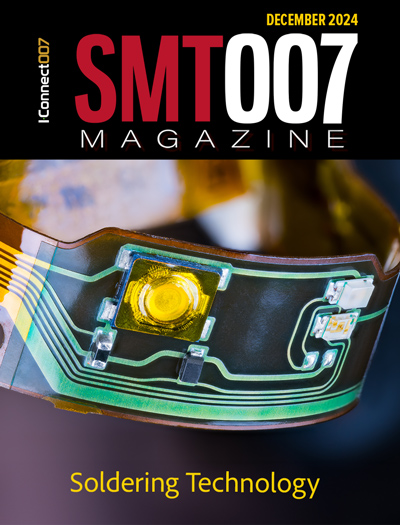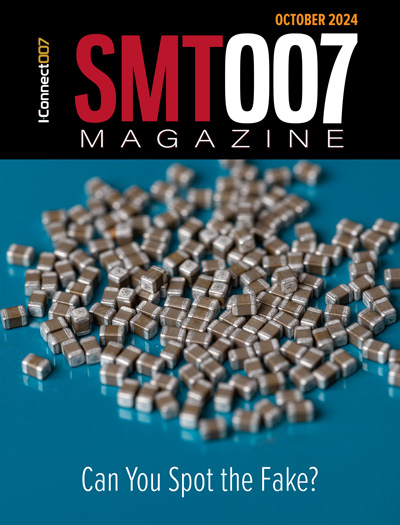-

- News
- Books
Featured Books
- smt007 Magazine
Latest Issues
Current Issue
Soldering Technologies
Soldering is the heartbeat of assembly, and new developments are taking place to match the rest of the innovation in electronics. There are tried-and-true technologies for soldering. But new challenges in packaging, materials, and sustainability may be putting this key step in flux.

The Rise of Data
Analytics is a given in this industry, but the threshold is changing. If you think you're too small to invest in analytics, you may need to reconsider. So how do you do analytics better? What are the new tools, and how do you get started?

Counterfeit Concerns
The distribution of counterfeit parts has become much more sophisticated in the past decade, and there's no reason to believe that trend is going to be stopping any time soon. What might crop up in the near future?
- Articles
- Columns
Search Console
- Links
- Media kit
||| MENU - smt007 Magazine
Root-cause Analysis and Problem-solving
November 1, 2024 | Happy Holden, I-Connect007Estimated reading time: Less than a minute
An essential skill for any process engineer in printed circuit fabrication is the ability to conduct root-cause analysis (RCA) and problem-solving. These are related to TQC and Six Sigma applications and are essential for customer support and continued profitability. All engineers will encounter these methods sooner or later, but it will likely be sooner if you are in product or process engineering in manufacturing.
I started my career in IC fabrication at Hewlett-Packard after serving in the Army and completing my graduate studies. In 1970, I was asked to help the PCB fabrication team members with some of their technical problems. I had two tools that most engineers in the PCB plant didn’t have at that time: engineering statistics, including design of experiments (DOE), and experience with problem-solving (TQC).
To read this entire article, which appeared in the October 2024 issue of PCB007 Magazine, click here.
Suggested Items
Are Our Stackup Rules No Longer Valid?
12/19/2024 | Cherie Litson, EPTAC MIT CID/CID+Are the stackup rules we used to follow no longer valid? It depends on what you’re designing. Electrical rules change depending on your circuit. Fabrication rules change depending on which fabricator you’re working with. Today, we just have more options, and sometimes, cost is a bigger rule than anything else. If you search online for information about layer stackups, trace widths, and hole sizes in PCBs, you’ll find a variety of resources.
Case Study: PCB Design Flaws Affect Product Cost
12/03/2024 | Matt Stevenson, ASC SunstoneIn the rapidly evolving aerospace industry, precision and reliability are paramount. “AeroTech Solutions” (not the company’s real name), an aerospace company specializing in satellite technology, recently faced a significant challenge that tested its operational integrity: A flaw identified in the PCB design of its latest satellite model led to unexpected delays and cost overruns.
Real Time with... SMTAI 2024: Summit Interconnect Doing Its Part to Rebuild Industry Expertise
10/29/2024 | Real Time with...SMTAIIn this interview from the recent SMTAI show, Nolan Johnson speaks with Jesse Vaughan from Summit Interconnect. Jesse hits the highlights for some of Summit's programs to promote skilled workers in our industry—programs such as apprenticeships, Emerging Engineers, and more.
Designers Notebook: Implementing HDI and UHDI Circuit Board Technology
10/23/2024 | Vern Solberg -- Column: Designer's NotebookTo accommodate new generations of high I/O semiconductor packaging, circuit board technology has undergone significant changes in both the fabrication process method and the criteria for base material selection. The reason behind these changes is the new high-function semiconductor package families that require more terminals than their predecessors and a significantly narrower terminal pitch.
Introducing the Ultra HDI Learning Pavilion at SMTA International 2024
10/07/2024 | SMTAThe SMTA is thrilled to announce the launch of the Ultra HDI (UHDI) Learning Pavilion, a first-of-its-kind experience dedicated to advancing Ultra-High Density Interconnect technology.


